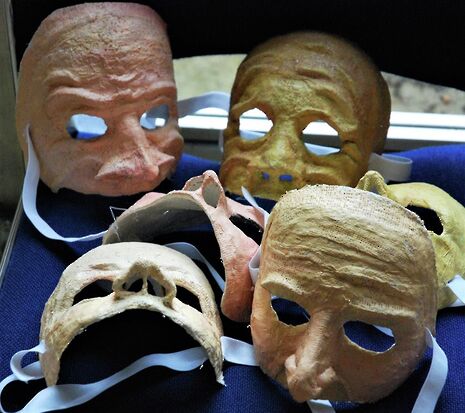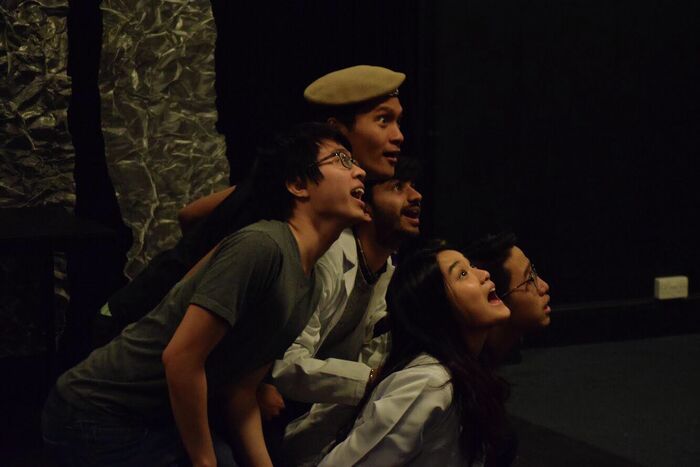Conversations with Myself preview
Iris Pearson watches rehearsals for the debut production from the Cambridge Mask Collective

A year abroad in Paris and Leo Benedict returns bursting with excitement. Cambridge theatre needs something completely new and he has found just the thing. This is the start of the Cambridge Mask Collective, and its first show is ‘Conversations with Myself’, directed by Benedict and Odette Baber Straw.
Benedict wrote the beginnings of ‘Conversations’ during his year abroad (in French) but this was just the start of it all. From the moment he brought it back to Cambridge, the piece became not his own, but a collaborative effort. He describes his work as different from that of a ‘theoretical playwright’ who goes away on their own and drafts and redrafts before finally presenting their work to a group of actors; this play has been crafted and recrafted and recrafted again, cut and restructured, rewritten, expanded, reduced, in a swirl of movement and constant change. There are 150 pages of unused material, Baber Straw tells me, and one of the hardest parts of this process has been deciding what to cut and what to keep, and not getting too attached to what doesn’t fit.
On one level this process, hinging on spontaneity, brings a vivacity to the performed final piece. On a practical level, it is a great set-up for the hectic rush that is a Cambridge theatre turnaround. The script was only finalised ten days before opening night, but because the process has improvisation at its core the actors have a wonderful confidence in what they are doing which cannot but pervade the scenes.
Benedict stresses that everyone on the Camdram page has had a creative stake in this production, and excitement characterises the experience for all of them. Each of the actors (Amelia Hills, Milo Callaghan, Victoria Zanotto, Hannah Ramezani) is from a different walk of theatre – from verbal realism to musical theatre to pantomime to physical theatre – so they each bring something different to the performance, merging themselves with the character, the person behind the mask with the face shaped on it.
It is Tim Otto who has designed and made the masks for ‘Conversations’, and Benedict praises his understanding of the simultaneous coherence and disparity needed in these masks: that is, they portray at once general characters and highly specified individuals; they are all made of the same white plaster and yet intensely different. In short, the paradoxes of the mask-making through which Otto has so carefully navigated epitomise the identity crisis which is at the centre of this play. The set in this case is the mask, the self, the character, and it is their stories and nothing else around the outside which Otto tries to tell through the visuals of his designs.
But this play is about more than aesthetics. I watched the cast go through a Meisner-esque exercise called koala (you can picture it) which forced them to think about something between the verbal and the physical qualities of their acting. It directed them to the tiny point of interpretation which is not defined by the body’s movement but also by its stillness and its very fact of being. Watching the actors act without masks made me think about the effect of these pieces of plaster: they at once conceal expression and craft it. Watching the actors act without masks meant I could only imagine what these lines would sound like with the full-mask aesthetic or how they would seem to an audience who had never heard them unmasked: and I can’t wait to see what these scenes look like in their full unravelling this week.
This project is energising. Benedict tells me he chose the actors for each other; he was thinking about what they could learn from each other, and what they had to teach. It is this sense of uncertain novelty, of fragility which is spontaneity, and of glorious instability in novelty which gives the confidence to go out there and show us a whole different answer to the question of student theatre. These actors definitely aren’t going through the motions, and I’m intrigued to see what they will bring us.
 News / SU reluctantly registers controversial women’s soc18 December 2025
News / SU reluctantly registers controversial women’s soc18 December 2025 Features / Should I stay or should I go? Cambridge students and alumni reflect on how their memories stay with them15 December 2025
Features / Should I stay or should I go? Cambridge students and alumni reflect on how their memories stay with them15 December 2025 News / Dons warn PM about Vet School closure16 December 2025
News / Dons warn PM about Vet School closure16 December 2025 News / Cambridge study finds students learn better with notes than AI13 December 2025
News / Cambridge study finds students learn better with notes than AI13 December 2025 News / Uni registers controversial new women’s society28 November 2025
News / Uni registers controversial new women’s society28 November 2025










